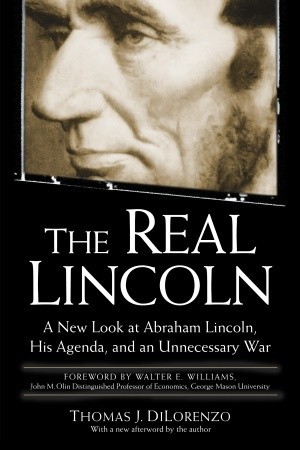Abraham Lincoln remains the central historical figure in modern America; the only others who can compete with him in their influence on the present and the degree of adulation accorded them are Franklin Delano Roosevelt and the Rev. “Dr.” Martin Luther King, Jr. Lincoln is praised for having accomplished two things: preserving the Union and freeing the slaves. The more sophisticated of Lincoln’s defenders claim that he also “refounded” the Union. True, but on what set of principles? Neoconservative defenders of Lincoln have performed philosophical somersaults, maintaining that Lincoln was simultaneously a conservative and a progressive, that he preserved the Union even while transforming it, and that he had to violate the Constitution in order to save it. Thomas J. DiLorenzo’s outstanding new book exposes these paradoxes as the ridiculous rationalizations they always were. He does so by concentrating on Lincoln’s actions rather than his words. DiLorenzo’s main theme is that Lincoln represented a militant and extreme incarnation of a certain statist tradition in American history. Lincoln’s political centralism, disregard for constitutional limitations, and mercantilism were Hamiltonian. Lincoln differed from his predecessor chiefly because he succeeded in transforming the republic along these lines.
On what principles, then, did Lincoln refound the Union? DiLorenzo identifies four of them: political centralization; state capitalism; anticonstitutionalism; and warfare as an acceptable instrument of moral and political reform. However, he misses two of great importance—ideological nationalism and political messianism/pharisaism—and he denies a third: racial egalitarianism. DiLorenzo can marshal all the racist and pro-black-colonization statements Lincoln ever made, but that does not change the historical realities that, because of Lincoln and his party, slavery was abolished; blacks (and potentially all other people of color) were made citizens; and suffrage was extended to the freedmen. For these, Lincoln will remain a hero in the eyes of progressives.
DiLorenzo details at length how Lincoln, a former Whig and disciple of Henry Clay, used the war—and the near-total power that it invested in him—as a means of enacting the Whig mercantilist program of high tariffs, national banking, public debt, and government subsidies for big business. Lincoln had always believed in this program, and he was not about to allow the secession of the Southern states to frustrate its long-awaited fulfillment. If DiLorenzo can be faulted here, it is for failing to explain how the Republicans masked their program of corporate welfare and privilege with false rhetoric about protecting American labor, defending free soil, fighting for the common man, etc. It is remarkable how little the Republicans have changed in 150 years. While the rhetoric has shifted, their true constituency remains the same.
For the leading lights of the historical profession as well as the punditocracy, Lincoln remains a mythological figure whose greatness, essential goodness, and heroism go unquestioned. They tolerate no independent analysis or revisionism; instead, they fiercely guard a set of axioms: The North was right, the South was wrong; the cause of the war was slavery and only slavery; the war was inevitable; the Southern “rebellion” was wicked and had to be crushed; secession was unconstitutional; Northern methods of war were moral, appropriate, and necessary to victory; Lincoln’s economic policies ushered in a modern industrial society of unprecedented wealth. Through the marshalling of evidence and reasoned argument, DiLorenzo refutes them all.
DiLorenzo shatters five persistent myths about the period. First myth: “The war was caused by slavery.” DiLorenzo reveals that, whatever factors motivated the South to secede, ending slavery and racial injustice was not why the North chose to fight. On the contrary, Northern elites waged war to restore the territorial integrity of the Union, regain federal tariff revenue, and prevent a free-trade confederation from surviving on their southern border.
Second myth: “Lincoln preserved the Union.” The Union was formed as a voluntary association of coequal and sovereign states. Lincoln destroyed this Union, substituted coercion for consent, and transformed a confederation of states into a unitary republican empire.
Third myth: “The North was fighting for the American principle of self-government.” The opposite was true. The North went to war to extirpate the right and practice of self-government, not only in the 11 states of the Confederacy but in the four border states as well, in each of which Lincoln overthrew the elected local governments and imposed military rule.
Fourth myth: “War was necessary to end slavery.” DiLorenzo disposes of this fallacy with a single devastating question: Why was the United States the only country in the 19th century that had to resort to war to end slavery? That it was ended in this way, rather than through peaceful reform, should be a cause for shame, not pride.
Fifth myth: “The war was just and moral.” It was just and moral only if you consider the burning and looting of private homes, farms, and plantations, the sacking of cities, the theft of private property, widespread rape (of both black and white women), and the execution of civilians just and moral. As DiLorenzo points out, centuries of Western legal and moral tradition had condemned such methods of warfare, even when the war itself was justified. By making deliberate war on civilians, Lincoln placed himself outside the canon of Western Christian civilization.
DiLorenzo will be criticized for relying mostly on secondary sources and for the polemical tone of his book, which nevertheless is far more historical and logical than most contemporary volumes on the subject. Historians and pundits tend to wander into the fogs of mysticism and abstraction when discussing Lincoln and the war. They rarely define liberty, equality, democracy, the Union, the Constitution, or the nation; instead, they conflate these various abstractions and make Lincoln their great champion. Not so with DiLorenzo, who gives specific content to these terms and shows how the Great Emancipator was the inveterate foe of each and every one of them.
[The Real Lincoln: A New Look at Abraham Lincoln, His Agenda, and an Unnecessary War, by Thomas J. DiLorenzo (Roseville, CA: Prima Publishing) 308 pp., $24.95]

Leave a Reply